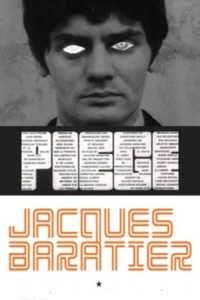 A product of the late 1960s French avant-garde, completed in 1968 but not released until 1970, that’s marked by decadence, surrealism and a loose reworking of THE MOST DANGEROUS GAME. Featured are actress Bulle Ogier, who’s appeared in many bizarre French films over the years, and the Spanish playwright-filmmaker Fernando Arrabal. He’s often mistakenly credited as the film’s director, but in fact that chore was accomplished by the late Jacques Baratier (of LA VILLE-BIDON and THE SATIN SPIDER). The film was quite notorious in its day but now seems fairly tame, with the perversity for which it was attacked being largely suggestive in nature.
A product of the late 1960s French avant-garde, completed in 1968 but not released until 1970, that’s marked by decadence, surrealism and a loose reworking of THE MOST DANGEROUS GAME. Featured are actress Bulle Ogier, who’s appeared in many bizarre French films over the years, and the Spanish playwright-filmmaker Fernando Arrabal. He’s often mistakenly credited as the film’s director, but in fact that chore was accomplished by the late Jacques Baratier (of LA VILLE-BIDON and THE SATIN SPIDER). The film was quite notorious in its day but now seems fairly tame, with the perversity for which it was attacked being largely suggestive in nature.
It begins with a wealthy man (Jean-Baptiste Thierree) entering a store and requesting a trap for a “really big animal.” The store’s eccentric owner (Arrabal) suggests a large tiger trap, which following a demonstration of the trap’s workings the man eagerly purchases. A bit later he approaches an attractive young woman criminal (Bulle Ogier) and her friend (Bernadette Lafont) as they’re being released from prison, giving them the address to his country home and making sure to mention that the place is well stocked with diamonds and jewelry. The man then heads home and strategically positions the trap outside.
That night the ladies break into the house. As the man watches from the shadows, they use a blow torch to burn through his safe in the hope of finding the precious jewels he spoke of—however, all they find in the safe is a severed human finger.
The gals continue exploring the house, discovering a dark room filled with S&M paraphernalia and a two-way mirror through which the man watches them. They settle in the kitchen, where they have a mini-feast of eggs and human fingers (of which the house evidently contains an abundance) while slides depicting perversely erotic imagery are projected on the walls around them.
The ladies grow increasingly destructive, smashing the man’s cupboards in scenes that play like outtakes from Vera Chytilova’s DAISIES (1966). They then get pursued through a room-full of mannequins by the man. They appear to gain the upper hand when they find him immobilized in a dentist’s chair with a paper-mache mask covering his face, but, as should be obvious by now, nothing in this twisted universe is as it seems…
Jacques Baratier favors ambiguity in his visual compositions and editing, particularly in sequences depicting action or violence, which are extremely opaque and confusing—an effect that seems quite deliberate. Visually the film is largely undistinguished, being lensed in oft-unerlit black and white imagery that reeks of cheapness. There are a few interestingly composed shots here and there, such a bit in which we view the two women cavorting in the background of a shot with the man’s head dirtying the foreground, and the scenery is often quite striking, although the poor lighting doesn’t exactly do the art direction justice.
Another notable is the bombastic score that incorporates an eerie chanting (evidently inspired by the monolith chant of 2001: A SPACE ODYSSEY), which was accomplished by Francois Tusques, who also penned the nonsensical narration that, in keeping with the film’s overall gist, refrains from ever explaining anything.
The dialogue, particularly that of Arrabal, who early on delivers a rambling monologue about spiritual animals and in the end turns back up to claim the whole thing was a “premonitory dream,” was evidently largely improvised. For that matter, the entire film feels like it was made up on the spot, which would explain the many motifs (such as the buying of the tiger trap) that are introduced but never paid off, and the fact that despite lasting only an hour the film feels so very long.
Vital Statistics
PIEGE (TRAP)
Argos Films
Director: Jacques Baratier
Screenplay: Jacques Baratier, Odilon Cabat, Ornella Volta
Cinematography: Georges Barsky
Cast: Bulle Ogier, Bernadette Lafont, Jean-Baptiste Thierree, Fernando Arrabal, Eve Mylonas, Arlette Emmery, Jackie Raynal
